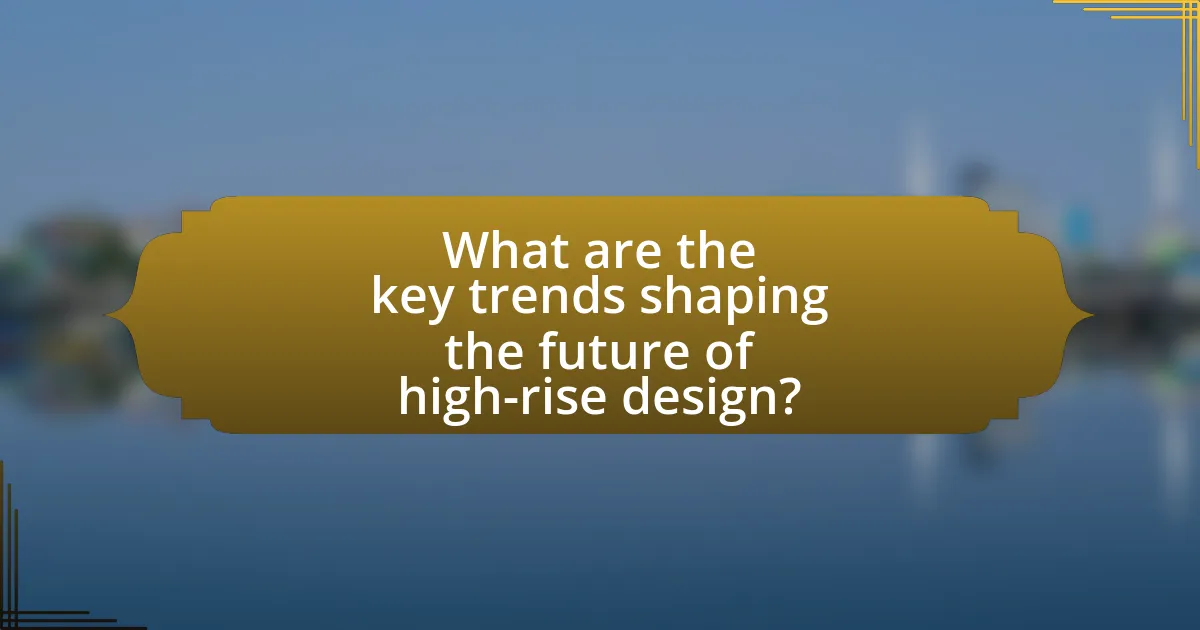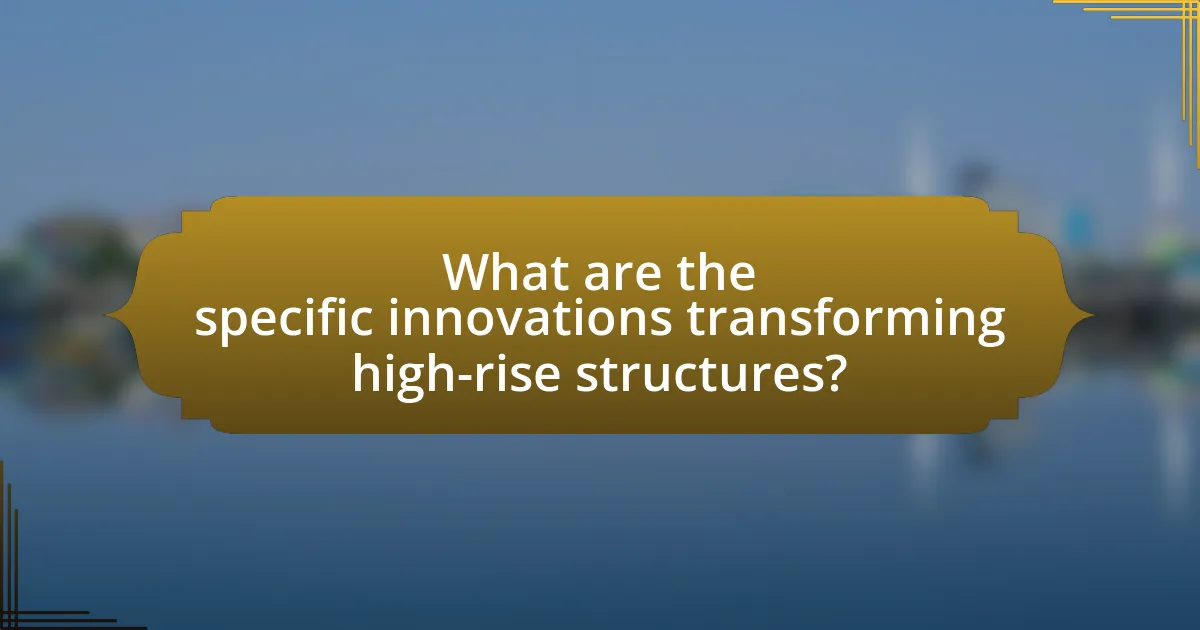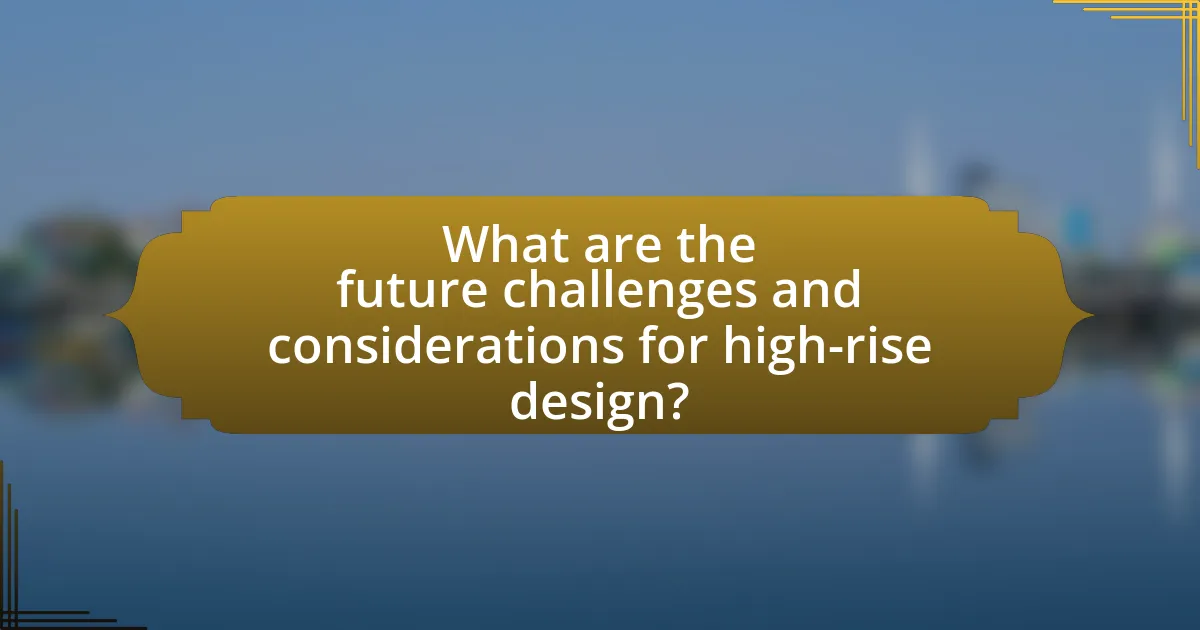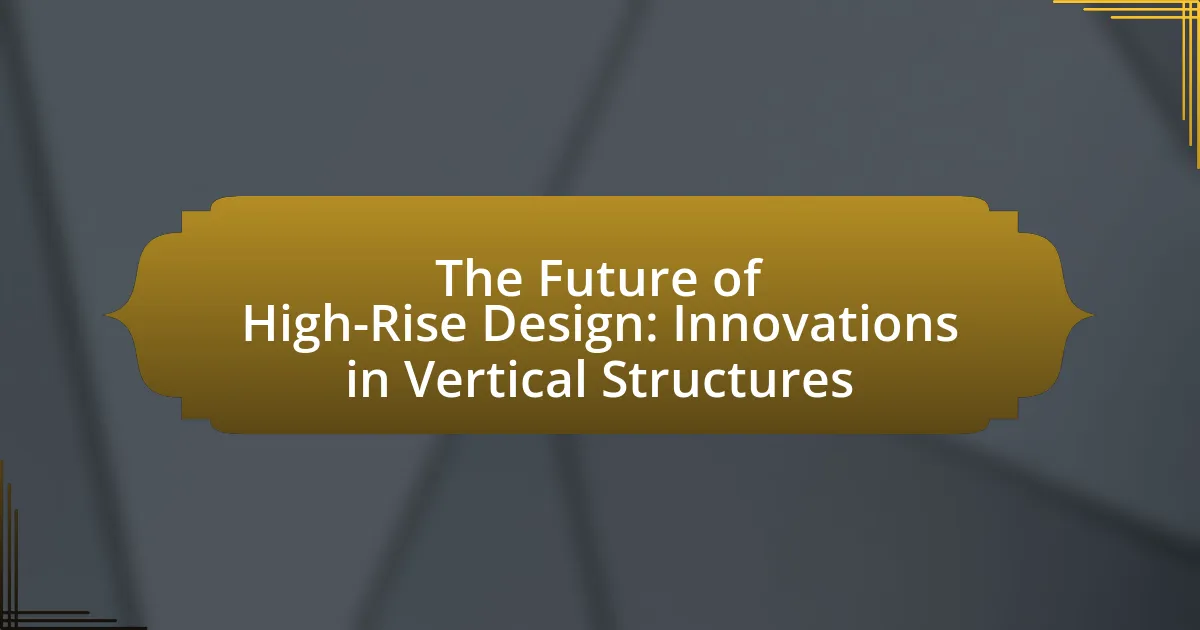The article focuses on the future of high-rise design, emphasizing key trends such as sustainability, smart technology integration, and modular construction. It explores how sustainability practices influence architectural choices, highlighting the use of energy-efficient materials and renewable technologies. The integration of smart building technologies enhances operational efficiency and occupant experience, while innovations in construction techniques, particularly modular methods, streamline project timelines and costs. Additionally, the article addresses the impact of urban density on high-rise development, the challenges architects face in urban environments, and the role of public spaces in enhancing community engagement. Overall, it provides a comprehensive overview of the innovations and considerations shaping modern vertical structures.

What are the key trends shaping the future of high-rise design?
Key trends shaping the future of high-rise design include sustainability, smart technology integration, and modular construction. Sustainability is increasingly prioritized, with architects focusing on energy-efficient materials and designs that reduce carbon footprints; for instance, the use of green roofs and solar panels is becoming standard in new developments. Smart technology integration enhances building management and occupant experience through automation and data analytics, as seen in projects like The Edge in Amsterdam, which utilizes IoT for energy efficiency. Modular construction is gaining traction due to its ability to reduce construction time and costs, exemplified by the rise of prefabricated components in high-rise projects, allowing for faster assembly and reduced waste. These trends collectively reflect a shift towards more environmentally responsible, technologically advanced, and efficient high-rise buildings.
How are sustainability practices influencing high-rise architecture?
Sustainability practices are significantly influencing high-rise architecture by promoting energy efficiency, reducing carbon footprints, and enhancing the use of renewable materials. Architects are increasingly integrating green technologies such as solar panels, rainwater harvesting systems, and energy-efficient HVAC systems into high-rise designs. For instance, the Bosco Verticale in Milan incorporates vertical gardens that improve air quality and reduce energy consumption for cooling. Additionally, the use of sustainable materials like recycled steel and low-VOC paints is becoming standard, which aligns with the global push for sustainable development. According to the World Green Building Council, buildings account for 39% of global carbon emissions, highlighting the critical role that sustainable high-rise architecture plays in mitigating climate change.
What materials are being used to enhance sustainability in vertical structures?
Sustainable materials used in vertical structures include cross-laminated timber (CLT), recycled steel, and bio-based composites. Cross-laminated timber is favored for its low carbon footprint and ability to sequester carbon, making it a viable alternative to traditional concrete and steel. Recycled steel reduces the demand for new steel production, which is energy-intensive, and can be reused multiple times without losing strength. Bio-based composites, made from natural fibers and resins, offer lightweight and durable options that minimize environmental impact. These materials collectively contribute to energy efficiency, reduced waste, and lower greenhouse gas emissions in high-rise construction.
How do energy-efficient designs impact the overall performance of high-rises?
Energy-efficient designs significantly enhance the overall performance of high-rises by reducing energy consumption and operational costs. These designs often incorporate advanced insulation, energy-efficient windows, and sustainable materials, which collectively lower heating and cooling demands. For instance, a study by the U.S. Department of Energy found that energy-efficient buildings can reduce energy use by 30-50% compared to conventional structures. Additionally, energy-efficient high-rises often utilize renewable energy sources, such as solar panels, which further decrease reliance on non-renewable energy and contribute to lower greenhouse gas emissions. This not only improves the building’s sustainability but also increases its market value and attractiveness to tenants, as energy-efficient buildings are increasingly preferred in the real estate market.
What role does technology play in modern high-rise design?
Technology plays a crucial role in modern high-rise design by enhancing structural integrity, energy efficiency, and occupant comfort. Advanced materials such as high-strength concrete and steel allow for taller and more resilient buildings, while Building Information Modeling (BIM) facilitates precise planning and collaboration among architects and engineers. Additionally, smart building technologies, including automated systems for lighting, heating, and cooling, optimize energy use and improve the overall living experience. According to a report by the Council on Tall Buildings and Urban Habitat, the integration of these technologies has led to a significant reduction in energy consumption in high-rise buildings, demonstrating their impact on sustainability and functionality.
How are smart building technologies integrated into vertical structures?
Smart building technologies are integrated into vertical structures through the implementation of advanced systems such as IoT sensors, automated controls, and energy management systems. These technologies enable real-time monitoring and management of building operations, enhancing energy efficiency, security, and occupant comfort. For instance, IoT sensors can track occupancy levels and adjust lighting and HVAC systems accordingly, leading to energy savings of up to 30% as reported by the U.S. Department of Energy. Additionally, automated controls facilitate seamless communication between various building systems, optimizing performance and reducing operational costs.
What innovations in construction techniques are emerging for high-rises?
Emerging innovations in construction techniques for high-rises include modular construction, advanced prefabrication, and the use of sustainable materials. Modular construction allows for sections of buildings to be manufactured off-site and assembled on-site, significantly reducing construction time and labor costs. Advanced prefabrication techniques enable the creation of complex building components in a controlled environment, enhancing quality and reducing waste. Additionally, the integration of sustainable materials, such as cross-laminated timber and recycled steel, not only improves the environmental footprint of high-rises but also meets increasing regulatory demands for sustainability in construction. These innovations are reshaping the efficiency, sustainability, and speed of high-rise construction projects.
Why is urban density driving the evolution of high-rise buildings?
Urban density is driving the evolution of high-rise buildings because it necessitates efficient land use in increasingly populated areas. As urban populations grow, cities face space constraints, prompting the need for vertical construction to accommodate housing, offices, and amenities within a limited footprint. For instance, cities like New York and Tokyo have seen significant increases in high-rise developments, with New York’s skyline featuring over 6,000 high-rise buildings as of 2021, reflecting the demand for maximizing usable space. This trend is further supported by urban planning policies that encourage vertical growth to reduce urban sprawl and promote sustainable living environments.
What challenges do architects face in designing for urban environments?
Architects face several challenges in designing for urban environments, including limited space, regulatory constraints, and the need for sustainability. Limited space in densely populated areas restricts the footprint of buildings, necessitating innovative vertical designs to maximize functionality. Regulatory constraints, such as zoning laws and building codes, can complicate the design process, requiring architects to navigate complex legal frameworks. Additionally, the increasing emphasis on sustainability demands that architects incorporate eco-friendly materials and energy-efficient systems, which can further complicate design choices. These challenges require architects to balance aesthetic considerations with practical and regulatory demands while addressing the environmental impact of their designs.
How do high-rises contribute to urban revitalization and community development?
High-rises contribute to urban revitalization and community development by increasing population density, which stimulates local economies and enhances public services. The presence of high-rise buildings often leads to the creation of mixed-use spaces that combine residential, commercial, and recreational facilities, fostering vibrant communities. For instance, a study by the Urban Land Institute found that areas with high-density developments experience a 20% increase in local business revenues due to higher foot traffic. Additionally, high-rises can improve infrastructure by attracting investments in transportation and public amenities, further supporting community growth and sustainability.

What are the specific innovations transforming high-rise structures?
Specific innovations transforming high-rise structures include advanced materials, smart building technologies, and sustainable design practices. Advanced materials such as carbon fiber and high-strength concrete enhance structural integrity while reducing weight. Smart building technologies, including IoT sensors and automated systems, optimize energy efficiency and occupant comfort. Sustainable design practices, like green roofs and rainwater harvesting, minimize environmental impact. These innovations collectively improve the functionality, safety, and sustainability of high-rise buildings, reflecting a shift towards more efficient urban living.
How are modular construction methods changing high-rise design?
Modular construction methods are transforming high-rise design by enabling faster construction timelines and reducing costs. These methods involve prefabricating building components off-site, which allows for simultaneous site preparation and module assembly, significantly shortening project durations. For instance, the construction of the 25-story “B2” building in Brooklyn, completed in 2016, utilized modular techniques that reduced the construction time by 60% compared to traditional methods. Additionally, modular construction enhances design flexibility, allowing architects to create innovative and sustainable structures that can be easily adapted to meet changing urban needs. This shift towards modularity is supported by advancements in technology and materials, which improve the structural integrity and aesthetic appeal of high-rise buildings.
What are the benefits of modular construction for high-rise projects?
Modular construction offers significant benefits for high-rise projects, including reduced construction time, cost efficiency, and improved quality control. By prefabricating building components off-site, projects can be completed up to 50% faster compared to traditional methods, as reported by the Modular Building Institute. This accelerated timeline not only minimizes labor costs but also reduces the overall project duration, allowing for quicker occupancy. Furthermore, modular construction enhances quality through standardized manufacturing processes, which can lead to fewer defects and higher durability. Studies indicate that modular buildings can achieve up to 20% lower construction costs due to reduced waste and efficient resource management.
How does modular construction affect project timelines and costs?
Modular construction significantly reduces project timelines and costs by enabling parallel construction processes and minimizing on-site labor. This method allows for the prefabrication of building components in a controlled factory environment while site preparation occurs simultaneously, leading to a reduction in overall project duration by up to 30% compared to traditional construction methods. Additionally, modular construction can lower costs by approximately 10-20% due to decreased labor expenses and reduced material waste, as factory settings optimize resource use. These efficiencies are supported by studies indicating that modular projects often complete faster and with fewer budget overruns, demonstrating the effectiveness of this innovative approach in high-rise design.
What advancements in vertical transportation are being implemented?
Advancements in vertical transportation include the implementation of smart elevators, which utilize artificial intelligence to optimize travel efficiency and reduce wait times. These systems analyze passenger patterns and adjust their operations accordingly, leading to energy savings and improved user experience. Additionally, advancements such as vacuum elevators and cable-free systems are being developed, allowing for more flexible building designs and increased capacity. For instance, the MULTI system by Thyssenkrupp employs magnetic levitation technology, enabling elevators to move both vertically and horizontally, thus maximizing space utilization in high-rise buildings.
How do new elevator technologies improve efficiency in high-rises?
New elevator technologies improve efficiency in high-rises by utilizing advanced systems such as destination dispatch, regenerative drives, and machine-room-less designs. Destination dispatch systems optimize elevator travel by grouping passengers based on their selected floors, reducing wait times and energy consumption. Regenerative drives capture energy during descent and feed it back into the building’s power system, enhancing energy efficiency by up to 30%. Machine-room-less designs save space and reduce construction costs, allowing for more flexible building layouts. These innovations collectively streamline vertical transportation, making high-rise buildings more efficient and sustainable.
What impact do smart mobility solutions have on high-rise accessibility?
Smart mobility solutions significantly enhance high-rise accessibility by integrating advanced technologies that streamline transportation within vertical structures. These solutions, such as smart elevators and automated transit systems, reduce wait times and improve the efficiency of moving people between floors. For instance, smart elevators use algorithms to optimize travel routes based on real-time demand, which can decrease travel time by up to 30%. Additionally, mobile applications that provide real-time information about elevator availability and transit options further facilitate user navigation in high-rise buildings. This integration of technology not only makes high-rise living more convenient but also supports inclusivity for individuals with mobility challenges, ensuring that all residents can access amenities and services efficiently.
What design strategies are being used to enhance occupant experience?
Design strategies enhancing occupant experience in high-rise structures include biophilic design, flexible spaces, and advanced technology integration. Biophilic design incorporates natural elements, such as greenery and natural light, which have been shown to improve well-being and productivity among occupants. Flexible spaces allow for adaptable layouts that can cater to various activities and preferences, promoting a sense of community and personal comfort. Advanced technology integration, such as smart building systems, enhances convenience and efficiency, providing occupants with personalized control over their environment. These strategies collectively contribute to a more satisfying and engaging living or working experience in vertical structures.
How does biophilic design influence the well-being of residents in high-rises?
Biophilic design significantly enhances the well-being of residents in high-rises by integrating natural elements into urban living spaces. This design approach fosters a connection to nature, which has been shown to reduce stress, improve mood, and increase overall life satisfaction. Research indicates that exposure to natural light, greenery, and water features can lower cortisol levels and promote mental health. For instance, a study published in the Journal of Environmental Psychology found that residents in biophilic-designed environments reported a 15% increase in well-being compared to those in traditional designs. Additionally, incorporating natural materials and views of nature can enhance cognitive function and creativity, further benefiting residents’ quality of life.
What role does public space play in the design of vertical structures?
Public space is integral to the design of vertical structures as it enhances accessibility, fosters community interaction, and promotes environmental sustainability. By incorporating public spaces such as parks, plazas, and communal areas within high-rise developments, architects create environments that encourage social engagement and improve the quality of urban life. For instance, the High Line in New York City exemplifies how elevated public spaces can transform urban landscapes, providing recreational areas that connect diverse communities while also increasing property values. This integration of public space into vertical design not only serves aesthetic purposes but also addresses practical needs, such as reducing urban heat and improving air quality, thereby validating its critical role in contemporary high-rise architecture.

What are the future challenges and considerations for high-rise design?
Future challenges and considerations for high-rise design include sustainability, structural resilience, and urban integration. As urban populations grow, high-rise buildings must incorporate eco-friendly materials and energy-efficient systems to minimize environmental impact. For instance, the World Green Building Council reports that buildings account for 39% of global carbon emissions, highlighting the need for sustainable practices in high-rise construction. Additionally, structural resilience against natural disasters, such as earthquakes and hurricanes, is crucial; the International Code Council emphasizes that modern high-rises must meet stringent safety standards to withstand such events. Lastly, urban integration requires high-rise designs to enhance community connectivity and public spaces, as noted in the Urban Land Institute’s research, which advocates for designs that promote social interaction and accessibility.
How will climate change impact the design of future high-rises?
Climate change will significantly impact the design of future high-rises by necessitating the incorporation of sustainable materials, energy-efficient systems, and climate-resilient structures. As global temperatures rise and extreme weather events become more frequent, architects and engineers will prioritize designs that reduce carbon footprints, such as using recycled materials and implementing green roofs to enhance insulation and manage stormwater. Additionally, the integration of renewable energy sources, like solar panels and wind turbines, will become standard to ensure buildings can generate their own energy. Research from the Intergovernmental Panel on Climate Change indicates that urban areas will face increased flooding and heatwaves, prompting the need for elevated structures and adaptive designs that can withstand these challenges.
What strategies can be employed to mitigate climate-related risks in high-rise buildings?
To mitigate climate-related risks in high-rise buildings, strategies such as implementing green roofs, enhancing energy efficiency, and utilizing resilient materials can be employed. Green roofs help manage stormwater and reduce urban heat, while energy-efficient systems lower greenhouse gas emissions. Additionally, resilient materials, such as those designed to withstand extreme weather events, enhance the structural integrity of buildings. According to the U.S. Green Building Council, buildings that incorporate these strategies can reduce energy consumption by up to 30%, demonstrating their effectiveness in addressing climate-related challenges.
How can high-rise designs adapt to extreme weather conditions?
High-rise designs can adapt to extreme weather conditions by incorporating resilient materials, advanced engineering techniques, and innovative design features. For instance, using materials like reinforced concrete and impact-resistant glass enhances structural integrity against high winds and storms. Additionally, implementing aerodynamic shapes reduces wind load, while features such as green roofs and rainwater harvesting systems improve sustainability and manage stormwater effectively. Research from the American Society of Civil Engineers indicates that buildings designed with these adaptations can withstand extreme weather events, thereby ensuring safety and longevity.
What regulatory and zoning challenges do high-rise projects face?
High-rise projects face significant regulatory and zoning challenges, primarily due to strict building codes, height restrictions, and land use regulations. These regulations often vary by municipality and can limit the maximum height of buildings, dictate the types of materials used, and establish setback requirements from property lines. For instance, cities like New York and San Francisco have specific zoning laws that control the density and height of high-rise developments to maintain the character of neighborhoods and ensure adequate light and air for surrounding properties. Additionally, high-rise projects may encounter challenges related to environmental impact assessments, which require thorough evaluations of how the construction and operation of tall buildings affect local ecosystems and infrastructure.
How do building codes influence high-rise design innovations?
Building codes significantly influence high-rise design innovations by establishing safety, structural integrity, and sustainability standards that architects and engineers must adhere to. These regulations dictate aspects such as fire safety measures, wind load requirements, and energy efficiency, which drive the development of new materials and construction techniques. For instance, the International Building Code (IBC) outlines specific requirements for high-rise buildings, prompting innovations like the use of lightweight, high-strength materials and advanced fire suppression systems. Consequently, compliance with building codes not only ensures safety but also fosters creativity in design, leading to more efficient and environmentally friendly vertical structures.
What are the implications of zoning laws on vertical development?
Zoning laws significantly influence vertical development by regulating building height, density, and land use. These regulations determine how tall structures can be, which directly impacts urban skyline aesthetics and the availability of housing or commercial space. For instance, cities like New York have specific zoning codes that dictate maximum building heights in different districts, thereby shaping the overall urban landscape and affecting real estate values. Additionally, zoning laws can promote or restrict mixed-use developments, influencing the integration of residential, commercial, and recreational spaces within high-rise buildings. This regulatory framework is essential for urban planning, as it aims to balance growth with community needs and environmental considerations.
What best practices should architects follow in high-rise design?
Architects should prioritize structural integrity, sustainability, and user experience in high-rise design. Ensuring structural integrity involves utilizing advanced materials and engineering techniques to withstand environmental forces, as evidenced by the use of high-strength concrete and steel in skyscrapers like the Burj Khalifa. Sustainability practices include integrating energy-efficient systems and green building certifications, such as LEED, which promote reduced energy consumption and environmental impact. Additionally, enhancing user experience through thoughtful design elements, such as natural lighting and communal spaces, contributes to the overall functionality and appeal of high-rise buildings, as demonstrated in projects like One World Trade Center, which incorporates public spaces and green areas.
How can collaboration among stakeholders enhance high-rise projects?
Collaboration among stakeholders enhances high-rise projects by fostering improved communication, resource sharing, and innovative problem-solving. When architects, engineers, contractors, and clients work together, they can align their goals and expectations, leading to more efficient project execution. For instance, a study by the Construction Industry Institute found that collaborative project delivery methods can reduce project costs by up to 10% and shorten schedules by 20%. This synergy allows for the integration of diverse expertise, which is crucial in addressing the complexities of high-rise construction, ultimately resulting in safer, more sustainable, and aesthetically pleasing structures.
What lessons can be learned from successful high-rise developments worldwide?
Successful high-rise developments worldwide demonstrate the importance of integrating sustainability, community engagement, and innovative design. For instance, the Bosco Verticale in Milan incorporates vertical gardens that improve air quality and enhance biodiversity, showcasing how green architecture can be effectively integrated into urban settings. Additionally, the One World Trade Center in New York emphasizes resilience through advanced engineering and safety features, illustrating the necessity of addressing environmental challenges and potential disasters in high-rise design. Furthermore, the Marina Bay Sands in Singapore highlights the value of mixed-use spaces that foster community interaction, proving that successful high-rises can enhance urban life by combining residential, commercial, and recreational areas. These examples collectively underscore that successful high-rise developments must prioritize sustainability, resilience, and community integration to thrive in modern urban environments.

Leave a Reply